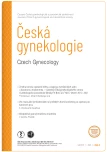Change in the trend of surgical treatment and staging of lymph nodes in endometrial cancer – results of the Oncogynecology Center, Department of Gynecology and Obstetrics, University Hospital Brno and Masaryk University in the years 2012–2021
Authors:
Petra Bretová; Luboš Minář; Vít Weinberger; Michal Felsinger; Michaela Koblížková
Authors‘ workplace:
Gynekologicko-porodnická klinika LF MU a FN Brno
Published in:
Ceska Gynekol 2022; 87(5): 308-316
Category:
Original Article
doi:
https://doi.org/10.48095/cccg2022308
Overview
Introduction: In the last decade, the view of endometrial cancer has shifted enormously, and the surgical approach or lymph node staging has changed significantly. We are presenting these changes with the University Hospital Brno Oncogynecology center’s results in the years 2012–2021 in the actual national and European guidelines context. Methods: The retrospective unicentric observational study, national and European guidelines review. Results: In the observation period, 715 endometrial cancer patients were treated in our clinic, and 636 of them underwent surgical treatment (89%). Concerning lymph node staging, firstly, there is a clear trend of expanding lymphadenectomy to the paraaortic area, followed by the sentinel node biopsy introduction in the years 2018–2019, and finally, the complete transition to this method as the main staging procedure in 2021, when this examination was performed in 73% of surgeries, even with high-risk cancers limited to the uterus. Within the sentinel node biopsy expansion, a gradual decrease in laparotomy approach (maximum 41% in 2016, 18% in 2021), and blood loss (2012–2019 median 100 mL, with a decrease to 50 mL in 2020–2021) was evident. A hospitalization length stabilized at a median of 5–6 days. Conclusions: Surgical treatment of endometrial cancer has become a minimally invasive procedure for the majority of patients, the average blood loss and hospitalization length have decreased. Sentinel node biopsy has become the preferred lymph node staging method.
Keywords:
endometrial cancer – sentinel lymph node – total laparoscopic hysterectomy – uterine manipulator – lymphadenectomy
Sources
1. Dušek L, Mužík J, Kubásek M, et al. Epidemiologie zhoubných nádorů v České republice. Masarykova univerzita. 2007 [online]. Dostupné z: http: //www.svod.cz.
2. Creasman WT, Odicino F, Maisonneuve P et al. Carcinoma of the corpus uteri. FIGO 26th annual report on the results of treatment in gynecological cancer. Int J Gynaecol Obstet 2006; 95 (Suppl 1): S105–S143. doi: 10.1016/S0020 - 7292 (06) 60031-3.
3. Bokhman JV. Two pathogenetic types of endometrial carcinoma. Gynecol Oncol 1983; 15 (1): 10–17. doi: 10.1016/0090-8258 (83) 90111-7.
4. Concin N, Matias-Guiu X, Vergote I et al. ESGO/ESTRO/ESP guidelines for the management of patients with endometrial carcinoma. Int J Gynecol Cancer 2021; 31 (1): 12–39. doi: 10.1136/ijgc-2020-002230.
5. Concin N, Planchamp F, Abu-Rustum NR et al. European Society of Gynaecological Oncology quality indicators for the surgical treatment of endometrial carcinoma. Int J Gynecol Cancer 2021; 31 (12): 1508–1529. doi: 10.1136/ ijgc-2021-003178.
6. Chovanec J, Feranec R, Mouková L et al. Guideline gynekologických zhoubných nádorů: standard – komplexní léčba zhoubných nádorů endometria. 2022 [online]. Dostupné z: http: //www.onkogynekologie.com/?page_id=80.
7. Colombo N, Creutzberg C, Amant F et al. ESMO-ESGO-ESTRO consensus conference on endometrial cancer: diagnosis, treatment and follow-up. Int J Gynecol Cancer 2016; 26 (1): 2–30. doi: 10.1097/IGC.0000000000000 609.
8. Ballester M, Dubernard G, Lécuru F et al. Detection rate and diagnostic accuracy of sentinel-node biopsy in early stage endometrial cancer: a prospective multicentre study (SENTI-ENDO). Lancet Oncol 2011; 12 (5): 469–476. doi: 10.1016/S1470-2045 (11) 70070-5.
9. Abu-Rustum NR. Sentinel lymph node mapping for endometrial cancer: a modern approach to surgical staging. J Natl Compr Cancer Netw 2014; 12 (2): 288–297. doi: 10.6004/ jnccn.2014.0026.
10. Uccella S, Bonzini M, Malzoni M et al. The effect of a uterine manipulator on the recurrence and mortality of endometrial cancer: a multi-centric study by the Italian Society of Gynecological Endoscopy. Am J Obstet Gynecol 2017; 216 (6): 592.e1–592.e11. doi: 10.1016/ j.ajog.2017.01.027.
11. Meng Y, Liu Y, Lin S et al. The effects of uterine manipulators in minimally invasive hysterectomy for endometrial cancer: a systematic review and meta-analysis. Eur J Surg Oncol 2020; 46 (7): 1225–1232. doi: 10.1016/j.ejso. 2020.03.213.
12. Padilla-Iserte P, Lago V, Tauste C et al. Impact of uterine manipulator on oncological outcome in endometrial cancer surgery. Am J Obstet Gynecol 2021; 224 (1): 65.e1–65.e11. doi: 10.1016/j.ajog.2020.07.025.
13. Gueli Alletti S, Perrone E, Fedele C et al. A multicentric randomized trial to evaluate the role of uterine manipulator on laparoscopic/robotic hysterectomy for the treatment of early-stage endometrial cancer: the ROMANHY trial. Front Oncol 2021; 11 : 720894. doi: 10.3389/fonc.2021.720894.
Labels
Paediatric gynaecology Gynaecology and obstetrics Reproduction medicineArticle was published in
Czech Gynaecology

2022 Issue 5
Most read in this issue
- Idiopathic granulomatous mastitis
- Distal vaginal agenesis and differential diagnosis of other causes of hematocolpos
- Effect of manual lymphatic drainage on upper limb lymphedema after surgery for breast cancer
- Psoriasis vulvae
